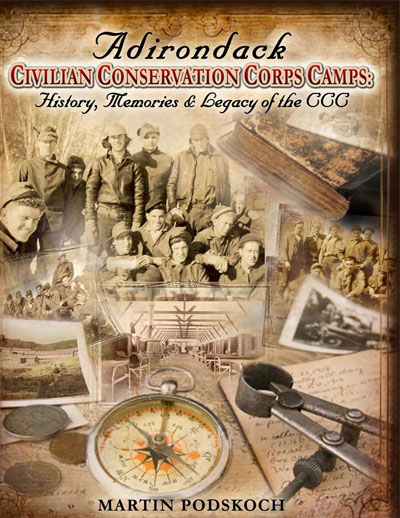Adirondack Civilian Conservation Corps Camps
History, Memories & Legacy of the CCC
The US Army supervised the camps, which had 200 men each. The earliest camps were set up in these Adirondack towns & counties: Arietta & Speculator (Hamilton); Bolton Landing (Warren); Tahawus, Newcomb, Schroon River, & Port Henry (Essex); Wanakena & Benson Mines (St. Lawrence); Paul Smiths, Goldsmiths, Tupper Lake, Lake Placid, and Fish Creek Pond (Franklin). There were eventually 26 camps in the Adirondacks.
A Closer Look
In the Adirondacks enrollees built trails, roads, campsites & dams, stocked fish, built & maintained fire towers, observervation cabins & telephone lines, fought fires, and planted millions of trees. The CCC disbanded in 1942 due to the need for men in WW II.
Nationwide, enrollees planted nearly 3 billion trees to help reforest America, constructed more than 800 parks nationwide, updated forest fire fighting methods, and built a network of service buildings and public roadways. In nine years, 2.5 million young men participated in restoring public appreciation of the outdoors.
Chronicling the CCC
In 2006 Martin Podskoch turned from chronicling the history of fire towers in the Adirondacks to gathering information on the CCC camps in the Adirondacks. Over the next five years Martin traveled to towns in and around the Adirondacks and gave presentations on the CCC camps. CCC alumni, their families, and friends shared their stories and pictures.
Clarence Petty, wilderness guide, pilot, district ranger, and conservationist, was one of the persons Martin Podskoch interviewed. Clarence first worked in 1933 as a forester at the Tupper Lake camp. He then advanced to camp superintendent at many other CCC camps till the CCC ended in 1942.
Petty stated: “Martin Podskoch records the accomplishments of the CCC camps throughout New York State, many in the Adirondacks. His interviews with CCC enrollees and their families and the marvelous photos of camp life captures the vitality of the young men who worked so hard to improve our forests, which had been ravaged by fires and lumbering. We must not forget their labors in the woodlands and state parks that continue to be enjoyed by millions today.”
Book Collection
Available titles from Podskoch Press
Event Calendar
Upcoming Speaking Engagements
Contact Marty
Have a question for the Author
